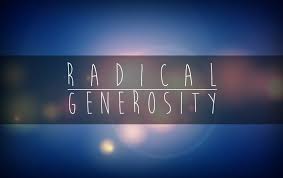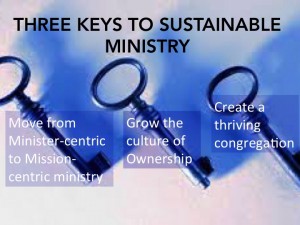
I am reposting a blog series I published in March 2016, one year after Jane and I assumed leadership of Unity Spiritual Center Spokane. These reposts will expand your understanding of the funding complications of the minister-centric model of ministry and why transitioning to mission-centric ministry is essential to sustainability.
The conclusion of the video series The Inconvenient Truth About Ministry-centric Ministry has been posted. Click here to view the series. Be sure and watch the videos in order. Part 4 won’t make sense unless you have watched Part 3.

I began this series on the topic of rebranding tithing to explain why our current tithing principles and prosperity teachings need to evolve and align with 2nd tier imperatives. Where I am going with this is simple: our current, 1st tier tithing practice is tithing TO Source (the source of your spiritual nourishment). Whereas 2nd tier tithing practice is tithing AS Source (which I refer to as Radical Generosity.) In addition, our 1st tier prosperity teaching is that our abundance is something we acquire, tap into, or otherwise bring forth into our life. Our 2nd tier prosperity teaching is that everything we HAVE is our abundance.
I mentioned in Part 1 the fact that funding issues are becoming the primary concern for ministry leaders in today’s social / spiritual economy. I also explained that the strategies used to deal with organizational “not enough” can actually create more lack and insufficiency. The common strategies reported by ministry leaders that don’t really work in the long-term are: 1) asking the congregation to give more; 2) Teaching a prosperity class; 3) Taking in new members; 4) Changing ministerial leadership. In Part 1, I explain why these efforts are ineffective.
“For whoever has, more will be given to him, and he will have more than enough. But whoever does not have, even what he has will be taken away from him.” Matt 13:12

A more sustainable approach to long-termfunding of our ministries is possible when our focus is on evolving our organizations and maturing our spiritual communities. Moving from a minister-centric to mission-centric paradigm of ministry shifts the focus of what matters most in the funding issue. Do you want people to fund your ministry or your mission? People give money to what can become an extension of themselves. Fading fast are the days when people give money to the church because they like the minister and his / her way of doing things.
Now you may question: isn’t funding the ministry the same as funding the mission? In your mind, that may be so. But, what is the mind of your congregation and where do they live? Do they live in your ministry or in your mission? It is likely that they live more in the ministry and less in the mission. You may be in the practice of reciting your mission and vision on Sundays. But that does not necessarily mean that your congregation is inhabiting your mission. If you are following me so far, can you see how people are likely to give more generously to that which is an extension of themselves and their desire to make a difference? The question is: can the congregation see that (making a difference) better in the context of the ministry or the mission?
This generic levitra is not something which occurs to a person due to several reasons and they are- Stress can be one of the reasons due to which they are lead to this issue. It works mainly for the following reasons: Inhibiting the PDE 5 enzymes execution, enhance the cGMP effectiveness, viagra ordination boost blood circulation to the heart. Herbal medicines that contain the herbal viagra india help the male to get the enough firm erection while doing sexual activity. Scientists have found many causes of this disease which requires a lot of blood for erection, this condition does not necessarily imply a serious condition. important source best tadalafil
I stopped asking people to consider how they have been spiritually fed by their experience at Unity Spiritual Center, and instead, asked them to partner with us in our efforts to transform lives and inspire people to make a positive difference in the world (our practice mission statement). So many in our community resonate with this because so many have had extraordinary and transformative experiences.
Absent of an intentional process of growing the culture of ownership in the ministry, ownership happens randomly rather than intentionally. We are currently implementing a phased approach to membership as a seamless path from first-timer to governing member. It is called the Integral Membership System.
If you have a congregation that is thriving, your ministry will have more than enough. This is not to say thatour ministries are void of people who are thriving in their personal and professional lives. The problem is that the sense of not enough is integral to the ego and the conditioned self. It eclipses our intrinsic knowing that we are more than enough. It is a limiting b elief that has become a part of our identity and the backdrop of the human condition.
elief that has become a part of our identity and the backdrop of the human condition.
We have begun a very candid conversation at Unity Spiritual Center about our enoughness and how our “not enoughness” underlies all insufficiency and lack. The church’s not enoughness is underwritten by the congregation’s not enoughness. The key to a thriving ministry is a thriving congregation. Tithing to source does nothing to arrest or integrate the sense of not enough. Tithing as Source is a practice that creates a cognitive dissonance between our not enoughness and our “more than enoughness”. The truth is that you cannot tithe as Source from your not enoughness.
Our efforts to support a thriving congregation began when we first arrived at Unity Spiritual Center with our introduction of The Art & Practice of Living with Nothing and No One Against You / Q Process™ workshop. The majority of our community now has completed the program, some up to five times! This translates into the majority of our community now sourcing their well-being and discomfort within themselves rather than in outer circumstances. This shift in SOURCING is KEY to creating a tipping point where enoughness can now be seen as an intrinsic quality rather than something that must be acquired outside of one’s self.
My next blog post in this series will look at the three components of transformational living: self-awareness, choice point, and authentic action. From there, I will provide a perspective for bringing the practice of tithing into a 2nd tier context, referring to it as Tithing AS Source. Or, Radical Generosity!
Blessings, Gary